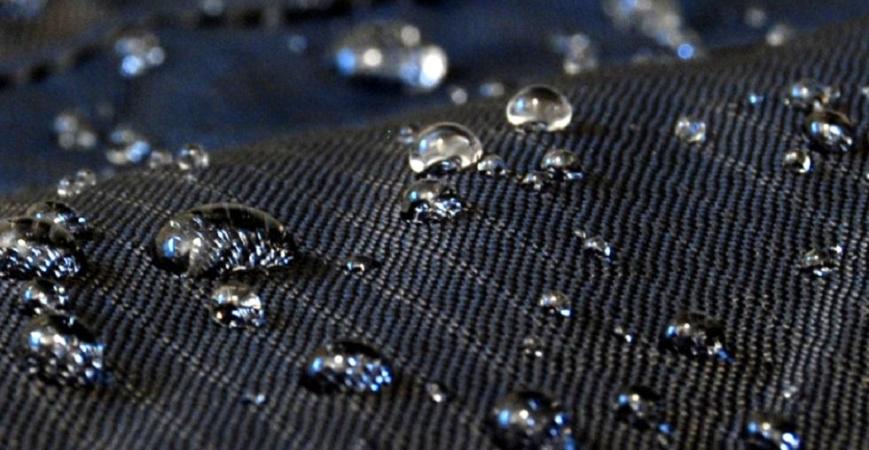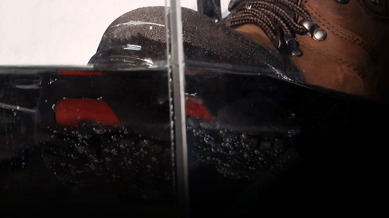Water-Resistant vs Waterproof: What's the Difference?
Here’s a question we get asked a lot:
‘Is water-resistant the same as waterproof?’
The answer’s simple. In a word, no.
They might sound similar, but there is a big distinction. But a lot of the time it’s not obvious by looking at a shoe. You try it - have a look at the two shoes in the image above. One is waterproof, one is water-resistant, but there’s nothing obvious or noticeable at first glance to tell you which is which. But beneath the leather, the difference in manufacturing and technology can be considerable.
In this article, we’ll tell you everything you need to know about the key features of water-resistant and waterproof work boots and how they’re made and tested, so you can feel confident and well informed about your outdoor safety footwear options going forward.
FIRST THINGS FIRST: DEFINITIONS
WATERPROOF:
A waterproof material or product is completely impervious to water penetration, which means no water can get in or out. A waterproof item of clothing will give the wearer protection from water for a significant period of time.
WATER-RESISTANT:
A water-resistant material or product will prevent water penetration, but only to a certain level. And because it isn’t totally impervious, the material will let water in or out when exposed to high levels.
When a boot is stitched together, the small holes made by the needle and thread will allow water in once saturated. And once water finds its way through these holes, the flexing action of the foot simply sucks more water in, and the result is inevitable: wet feet. As a rule, unless it has a waterproof membrane (which is essentially a plastic bag placed behind the material upper) the shoe itself will never be completely waterproof.
In a nutshell: the fact that footwear may be water-resistant does not mean it will be waterproof.
And it’s this misunderstanding that can create problems. But it’s an understandable mix-up: after all, the word ‘resistant’ strongly suggests that it will keep water out. As a result, many people end up purchasing water-resistant safety boots thinking they will keep their feet completely dry when they won’t. Inevitably, this leads to wet feet and frustrated wearers. More serious though is that wet feet are uncomfortable, which is a distraction, And if you’re working in a role where hazards are common and safety is vital, a lack of focus due to a lack of comfort can have very serious consequences.
HOW ARE WATERPROOF BOOTS TESTED?
Simple – they take a bath. Unfortunately for them, it’s not a warm, bubbly and relaxing one – it's quite a tough procedure called a Dynamic Footwear Water Penetration Test. The boots are put on a machine and submerged in a tank of water at a specific angle, and the machine then makes the boot repeatedly flex to show if any water seeps through and in. If it lets in less than 3cm ² then they are considered waterproof.
IDENTIFYING A WATERPROOF BOOT
Sometimes the shoe or boot will have ‘waterproof’ or water-resistant' written on the sole or on the boot itself, but to make sure, your best bet is to look at the tongue.
Ok, be warned: this next bit is slightly confusing...
%20(2).png?width=384&name=V12%20waterproof%20symbol%20(e)%20(2).png)
On the inside of the boot’s tongue, you’ll see amongst other details a series of letters. If you see the letters WR (circled red in the image) this means that the boot is waterproof.
Now, I know what you’re all thinking:
If it’s waterproof, why doesn’t it say WP for waterproof? WR suggests it’s water-resistant, and you just told us that water resistant isn’t waterproof!
Agreed, it is a little unclear, but that’s just how the ratings work. Some industry experts say this is because no shoe is ever truly waterproof, because it’ll always have a big hole in it – the one you put your foot in.
If your next question is: If WR means waterproof, what’s the code for water-resistant?, the answer is WRU. This stands for ‘Water-resistant upper,’ and means that the shoe has been treated with a substance to repel water to a certain level, but it won’t have a waterproof membrane inside which means it won’t be fully waterproof.
SAFETY STANDARDS ARE CHANGING
Recently, the EN ISO 20345: 2011 safety standards were updated to EN ISO 20345: 2022, which has changed certain safety codes, including water-resistance.
If your existing boots are water-resistant, it's very likely will have a WRU code. Going forward, the new code for water resistance is WPA (meaning water penetration and absorption) so this symbol could start appearing on your boots in the coming years. The symbol for waterproof boots remains unchanged.
So, to clarify:
WR = WATERPROOF
WRU = WATER-RESISTANT
WPA = WATER-RESISTANT (if tested to the new EN ISO 20345: 2022 standards)
BREATHABILITY
The big drawback with many waterproof boots is that often, they can make feet hot and sweaty. Why? The membrane makes the boot waterproof because it acts as a wall between water and foot, but it also acts as a wall between your foot and the air. That’s why a lot of people who wear waterproof garments complain that while they're great at keeping water out, because the fabric isn't breathable, the amount of sweat they generate means that they end up as soggy and damp as they would have been if the rain had got in!
Generally, it's the cheaper waterproof shoes that will have less breathable membranes. V12 waterproof membranes are full of microscopic holes, each one many times smaller than a water molecule, but large enough to allow perspiration to escape. This way, you’ve got the perfect scenario: no moisture coming in, plenty of moisture going out.
THE RIGHT BOOT FOR YOU
Knowing what type of boot you need to keep safe and comfortable at work is therefore essential. For example, if you work in the rail or oil industry and you’re battling with rain, sea and storms all day, you’re going to want to get yourself a pair of fully waterproof boots. Alternatively, if you’re working in sectors like aerospace or the automotive industry and find yourself less exposed to the elements, then water-resistant, rather than waterproof footwear will be your best bet.
THE DANGERS OF WET FEET
When it comes to making any safety footwear purchase, the primary concern should always be your health and safety. If you’re still in two minds about whether or not you need waterproof or water-resistant boots – or you think your employer might be offering you the wrong type of boot, it’s worth knowing the health and safety implications of wet feet. When feet suffer long-term water exposure, it can lead to a range of problems such as:
- blistering
- swelling
- numbness and itching
- athlete's foot
And left untreated, these ailments can turn into life-limiting health complications such as impaired blood vessels and tissue damage. Waterproof footwear shouldn’t be a luxury or a comfort benefit – it should be a specific feature of your outdoor footwear based on the demands and conditions you face in your industry.
So now you know your waterproof from your water-resistant, your membranes from your molecules, and your dry feet from your athlete’s feet. And you also know just how important it is to get the right type of boots to avoid the dangers of wet feet. But the most important thing to take from this piece are these three little words. RIGHT FOR YOU. Whether you choose a water-resistant or waterproof outdoor boot, just make sure that based on the challenges and nature of your job, it’s right for you.


